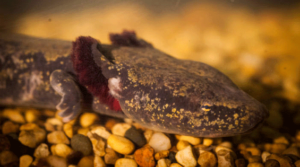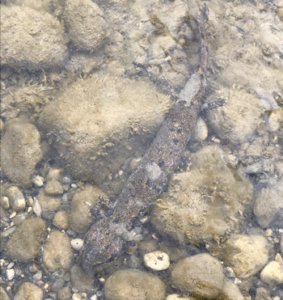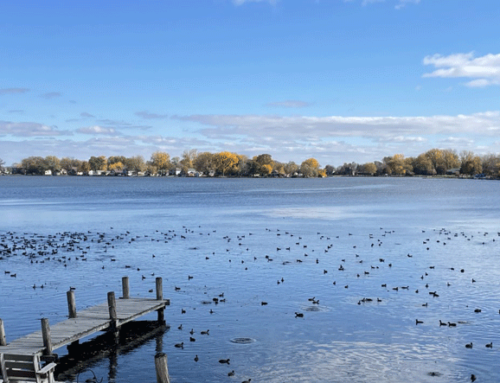This month’s species spotlight highlights Wisconsin’s largest and only fully aquatic salamander: the mudpuppy (Necturus maculosus)! This brown or grayish salamander typically has dark spots and deep red, feathery gills. These salamanders have a finned tail too. Mudpuppies can grow up to 16 inches (1.33 feet) long!

Mudpuppy – USFWS National Digital Library
The skin of mudpuppies is very slimy, though the rumors that mudpuppies are poisonous are not true. It is still best to avoid touching them and leave them be if you find one because they have sensitive, permeable skin.
Habitat & Diet
Mudpuppies live their whole lives in the water of lakes and rivers. They prefer areas with large flat docks and will live in underwater holes. Mudpuppies eat aquatic invertebrates (animals in the water without a backbone) such as worms and insect larvae. They will also eat small fish and other amphibians.
Behavior & Population Info
Mudpuppies breed in late fall and spawn in June. Eggs hatch in July or August. It is estimated mudpuppies can live up to 20 years old.
Mudpuppies are typically nocturnal, meaning they are most active at night. They may be more active during the day if the live in murky/muddy water but are tricky to spot and study. Currently, Wisconsin’s mudpuppy populations have not been extensively studied, so it is unknown how the species’ population is faring in Wisconsin. Their status is listed as common, but have recently been listed as a species of special concern in Minnesota, and are threatened in Iowa and Illinois. It is known that mudpuppies in Wisconsin are the only host of the Salamander Mussel, a state threatened species. In the winter, mudpuppies may be a common bycatch during the ice-fishing season, and in 2022 the Wisconsin DNR asked for help documenting mudpuppy observations. Mudpuppies are active year round, even under winter ice!

Mudpuppy – iNaturalist – thismia – CC BY-SA 4.0
Article written by Katie Reed, Winnebago Waterways Coordinator: katherine@fwwa.org
Featured Image Credit: Wisconsin DNR
Additional Image Credit 1: US Fish and Wildlife Service – National Digital Library
Additional Image Credit 2: thismia CC BY-SA 4.0
Sources:
DNR Asks Public to Report Mudpuppy Observations – WDNR
Mudpuppy: NECTURUS MACULOSUS – WDNR
Mudpuppy – Endangered Resources – WDNR
Mudpuppy – Environmental Education For Kids
Winnebago Waterways is a Fox-Wolf Watershed Alliance recovery initiative. Contact us at wwinfo@fwwa.org








